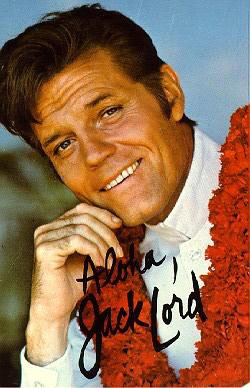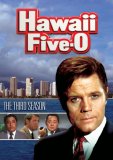| Reviews & Columns |
|
Reviews DVD TV on DVD Blu-ray 4K UHD International DVDs In Theaters Reviews by Studio Video Games Features Collector Series DVDs Easter Egg Database Interviews DVD Talk Radio Feature Articles Columns Anime Talk DVD Savant Horror DVDs The M.O.D. Squad Art House HD Talk Silent DVD
|
DVD Talk Forum |
|
|
| Resources |
|
DVD Price Search Customer Service #'s RCE Info Links |
|
Columns
|
|
|
Hawaii Five-O - The Third Season
Indeed, Hawaii Five-O was part of a trend in the late-'60s / early '70s toward crime and mystery shows where supporting characters rarely did much more than support the star. On Ironside, Raymond Burr's autocratic independent investigator barks orders and rattles off theories about that week's crime spree while co-stars have little to do but stand there on the sidelines and take the verbal abuse. Hawaii Five-O operates in much the same way: it's Jack Lord's show - he's the star and his Detective Steve McGarrett (of the fictional state police agency) comes up with all the answers and usually nabs the bad guy himself or, minimally, supervises their arrest. Supporting players James MacArthur (as local boy Det. Danny Williams), Kam Fong (Chinese-American Det. Chin Ho Kelly), and Zulu (Native Hawaiian Det. Kono Kalakaua) function as loyal disciples, out on the streets doing Five-O's leg work.
Adhering to this formula means shows like Hawaii Five-O rise and fall on the quality of their teleplays and the charisma of the actors to carry viewers through weaker episodes. Lord's enigmatic workaholic McGarrett is a fascinating character, but only rarely do episodes scratch below the surface, such as in the first season two-parter, "Once Upon a Time." In the third season, Danny gets a girlfriend (Anne Archer!) only to have her murdered by an apparent serial killer. We hear nothing about her before or after this (at least not that this reviewer is aware of) and while the show's a good one, it's a good example of the limitations of so many programs of the era.
On the other hand, if Hawaii Five-O does indeed rise and fall on the basis of its scripts, then its third season (1970-71) is a generally strong and varied one, quality-wise pretty much on the level of the previous two years. Three exceptional shows exemplify Five-O's variety of teleplays: an above average international espionage story, one light-hearted caper cat-and-mouse episode, and a controversial third that generally succeeds in another area Hawaii Five-O occasionally tackled: topicality.
Season-opener "And a Time To Die..." brings back Wo Fat (Khigh Dhiegh), McGarrett's chief nemesis and the Blofeld to his James Bond in spy genre-influenced shows. Featuring a very young Donald Moffat (later LBJ in The Right Stuff) as a doctor whose little daughter has been kidnapped by the Red Chinese super-agent, the episode is notable for providing Wo Fat with a semi-tragic backstory triggered by his relationship with the little girl, whom he nonetheless is ready to murder if the doctor refuses his demands to let an American spy die on the operating table. Ironically audiences practically learn more about Wo Fat's past in this guest shot than they would about McGarrett's during the entire run of the show.
In contrast, "Over 50? Steal" is a real charmer, a delightful and very clever caper show with Hume Cronyn guest starring as a former insurance investigator turned gentleman thief engaged in a playful game of cat-and-mouse with Five-O, with Cronyn and his clever deceptions and disguises always several steps ahead of the law. Written by E. Arthur Kean, "Over 50? Steal" is a refreshing change of pace for several reasons: for one thing, McGarrett and his men are actually amused by the thief's ingenuity and their reactions each time he gets away are priceless. Cronyn is a delight and doubtlessly was attracted by its script; he almost never did this type of show. He and writer Kean would be back in a 1972 show, "Odd Man In."
The real stand-out though is "To Kill or Be Killed," an episode not quite as powerful as its good intentions, but fascinating as a pop culture document on the Vietnam era*. Michael Anderson, Jr. guest stars as "Michael," the troubled son of a respected Brigadier General (prolific TV character player John Anderson, no relation to Michael) who served in the last two wars. Called up for duty, the lad debates whether to report or flee to Canada, but after visiting his newly-returned home war hero older brother Jack (Peter Jason), Michael becomes the chief suspect in Jack's sudden and mysterious death. (Spoilers) As it turns out, Michael committed suicide, haunted by memories of his complicity in a My Lai-type massacre.
The episode had to have been produced almost exactly a year after Seymour Hersh broke the story of My Lai, well after Army Major Colin Powell's controversial investigation, which concluded that relations between the U.S. military and the South Vietnam population were "excellent." By the time the episode aired in mid-January 1971 the tide of public opinion had turned against the war and that month Congressman Ron Dellums's Vietnam war crimes exhibit, set up in an annex to his office, was in the news.
Hawaii Five-O's take is antiwar in general, but doesn't really take a specific position on Vietnam, either. What it does attempt to dramatize is the desperation of those having to choose between serving in a war they don't believe in, going to jail, or fleeing to Canada, possibly without the option of ever returning. Michael Anderson's sincere performance carries the show though a subplot involving Danny's efforts to infiltrate the underground hippie railroad to Canada is more that a little ludicrous, with Danny's pseudo-hipster talk coming off as laughably unconvincing. John Anderson is appropriately stiff and proper in some scenes, but he's basically miscast because of other scenes that require him to be more emotionally expressive, not Anderson's strong suit.
Other guest stars this season include Gerald S. O'Loughlin, Nancy Wilson, Harry Guardino, semi-regular Richard Denning, Eric Braeden, Martin Sheen, Diana Muldaur, Edward Andrews, Ed Flanders, Albert Paulsen, Andrew Duggan, Peter Bonerz, John Vernon, Simon Oakland, Barry Atwater, Alfred Ryder, Ray Danton, Lloyd Bochner, Albert Salmi, Joyce Van Patten, Madlyn Rhue, Joan Van Ark, R.G. Armstrong, William Schallert, Royal Dano, Tim O'Connor, Paul Stewart, Joy Bang, Roger C. Carmel, Vera Miles, Gary Collins, and Pernell Roberts.
Video & Audio
Hawaii Five-O: The Third Season looks about as good as the previous two years and gets high marks. The full frame image shows off the Hawaiian locales to great advantage, and the episodes don't appear to have been time-compressed or edited. The "big wave" prologue bumper and "episodic promos" are available on most episodes. The Dolby Digital mono is likewise strong, if a bit tinnier than seasons one and two; an alternate Spanish audio track is included, along with optional Spanish and Brazilian Portuguese subtitles. The 24 second-season shows are spread across six single-sided, dual-layered discs.
Extra Features
The only supplement are those spoiler-filled episodic promos. Fortunately, viewers have the options to play them or not before each episode, which hasn't been the case with other cop/detective shows. (Watching The Rockford Files, I find myself grabbing the mute button and blocking my view of the TV with my remote so as not to spoil the episode I'm about to watch. This is much more convenient.)
Parting Thoughts
CBS and Paramount have, once again, done a fine job with Hawaii Five-O: The Third Season. The shows are hit-and-miss but generally above average, and the best ones eminently watchable. Recommended.
* Writer Anthony Lawrence discusses this script here at classictvhistory.com.
Film historian Stuart Galbraith IV's most recent essays appear in Criterion's new three-disc Seven Samurai DVD and BCI Eclipse's The Quiet Duel.
|
| Popular Reviews |
| Sponsored Links |
|
|
| Sponsored Links |
|
|
| Release List | Reviews | Shop | Newsletter | Forum | DVD Giveaways | Blu-Ray | Advertise |
|
Copyright 2024 DVDTalk.com All Rights Reserved. Legal Info, Privacy Policy, Terms of Use,
Manage Preferences,
Your Privacy Choices | |||||||
















